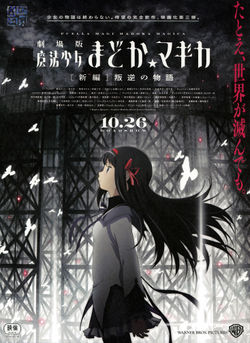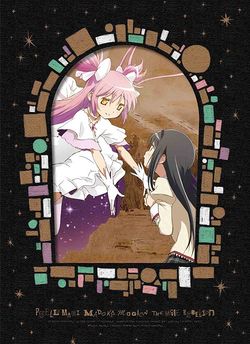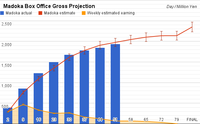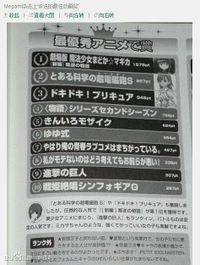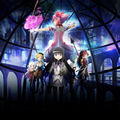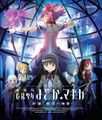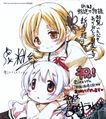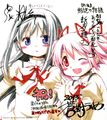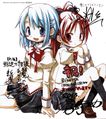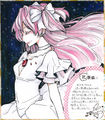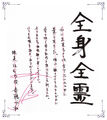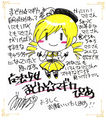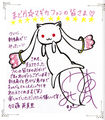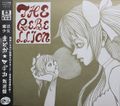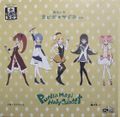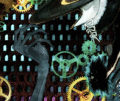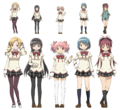Puella Magi Madoka Magica the Movie: Rebellion
This section is in need of attention.
The following section does not fit satisfactory wiki standards. It may be missing information, containing unconfirmed speculation outside of the speculation section, or have information that is outdated, in need of a rewriting, condensing, expansion, etc. If you wish to help fix up this section, please contribute on the editing page here.
This section may contain major spoilers!
Please refrain from reading if you are not yet familiar with all the latest media released."Even if this world will crumble as well." ~ Red text on the first Rebellion movie poster.
"Hope, or despair." ~ Large text on the second Rebellion movie poster.
Puella Magi Madoka Magica the Movie: Rebellion (劇場版 魔法少女まどか☆マギカ[新編]叛逆の物語 Gekijōban Mahō Shōjo Madoka Magika [Shinpen]: Hangyaku no Monogatari, lit. "Puella Magi Madoka Magica the Movie [New Edition]: The Rebellion Story") is the third movie of the Puella Magi Madoka Magica the Movie trilogy, serving as a sequel to the story. The movie premiered in Japan on October 26th, 2013. It is 120 minutes long.
The opening theme is "Colorful" (カラフル Karafuru) by ClariS and the ending theme is "Kimi no Gin no Niwa" (君の銀の庭, "Your Silver Garden") by Kalafina.
Summary
Madoka and the other magical girls reappear at Mitakihara fighting some new creatures born from humans' negative feelings known as "Nightmares" (ナイトメア Naitomea), having no recollection about what previously happened. However, Homura realizes something is amiss and after some investigation recovers her lost memories and realizes that she, Madoka, the other girls and several of their friends are trapped in an alternate version of Mitakihara City inside a witch's barrier. As Homura realizes that the witch is none other than herself, Kyubey appears and reveals that she had fallen into despair. When she was about to become a witch, he isolated her Soul Gem to set a trap for Madoka, hoping to understand and control the Law of Cycles.
However, when Madoka appeared to retrieve Homura, she had forgotten about her duty as the Law of Cycles and her powers, thus Kyubey kept observing her until that point. Having recovered her memories, Homura forces herself to complete the witch transformation at the cost of having her soul destroyed, to protect Madoka from the Incubators. At that moment Sayaka and a new girl named Nagisa Momoe, whose witch form is actually Charlotte—the witch that killed Mami—lead Madoka and the others in breaking the barrier to reach Homura's real body. Madoka recovers her memories and power as the Law of Cycles and reaches for Homura, but the latter releases the curse in her Soul Gem which she reveals is not one of despair, but love. With this power, retaining her human form, Homura suppresses Madoka's powers while transcending into what she considers to be a demon.
Afterwards, Homura captures Kyubey and rewrites reality so he and his kind bear the curses of the world while Madoka can return to a normal life. But Homura realizes that Madoka will eventually remember the truth and regain her divinity, accepting that they might become enemies should that time come. A post-credits scene shows Homura seated in a chair while watching over Mitakihara City and a badly-beaten and anxiety-riddled Kyubey in the vicinity. After dancing over him and staring into the horizon, Homura leans over and falls off a cliff.
Synopsis
- See: Rebellion/Synopsis
Characters
- See also: Madoka Magica Characters
Madoka Kaname
Japanese text: 希望を願う魔法少女がやがては絶望し魔女になる悲劇の連鎖から、全ての魔法少女を解き放つことを願い魔法少女となる。その願いは非常に大きなものであり、まどか自身は新たなる世界の概念と化してしまった。
English translation: The magical girl who wished to release all magical girls from the tragic chain of wishing for hope as magical girls and eventually falling into despair as witches. Due to the grandiose nature of that wish, Madoka herself became a concept of the new world.
Homura Akemi
Japanese text: まどかを魔法少女にさせないため、幾度となく同じ時を繰り返した少女。理が変った世界で、まどかがいた事を唯一覚えている存在であり、その意思を継いで魔法少女として戦い続けている。
English translation: The girl who repeated time on several occasions to prevent Madoka from becoming a magical girl. In the world with its laws rewritten, she is the only being left who remembers that Madoka was there. And succeeding that will, she fights as a magical girl.
Sayaka Miki
Japanese text: まどかの親友で、幼なじみの怪我の治癒を願い魔法少女となる。幸せを祈った分、呪いをため込み魔女へと化し、杏子と共に命を散らせた。まどかの願いにより、魔女になることもなく穏やかな最後を迎えた。
English translation: Madoka's close friend who became a magical girl when she wished for her childhood friend's wounds to be healed. When she gathered an amount of curses equal to the amount of blessings she wished for, she became a witch and lost her life alongside Kyoko. Through Madoka's wish, she was greeted by a calm, peaceful final moment without becoming a witch.
Mami Tomoe
Japanese text: まどかやさやかたちの先輩にあたる見滝原の魔法少女。お菓子の魔女との戦いにおいて命を落としたが、まどかの願いによりその悲劇は消え去り、魔法少女を続けている。
English translation: A magical girl in Mitakihara who is senior to Sayaka and Madoka. She lost her life in the fight with the witch of sweets, but by Madoka's wish, that tragedy was erased, and she continues her life as a magical girl.
Kyoko Sakura
Japanese text: 隣の町からきた魔法少女。他の誰かの為に魔法を使うさやかに反発していたが、自分と似ていることから気をかけるようになる。そして、魔女と化したさやかを救うために自らの命をかけた。まどかの願いがかなえられた世界で魔法少女を続けている。
English translation: A magical girl from a neighboring town. She opposed Sayaka for using magic for the sake of others, but came to realize that the two of them were similar. And then she risked her own life to save Sayaka who had become a witch. She continues her life as a magical girl in the world granted by Madoka's wish.
Nagisa Momoe
Japanese text: 新たに現れた魔法少女。その姿は幼く、何を願い魔法少女になったのか、また何故現れたのかは一切わからない。
English translation: A new magical girl has appeared. She has a childlike appearence and what she wished for to become a magical girl or why she has appeared is not known.
Kyubey
Japanese text: 宇宙から来た謎の生き物。第二次性徴期の少女の希望から絶望への相転移エネルギーを利用する事を狙っていたが、まどかの願いがかなえられた後の世界では別の方法でエネルギー確保をねらっている。
English translation: A mysterious animal from outer space. Their goal was to use the energy converted from the change of hope to despair in pubescent girls, but in the world granted after Madoka's wish, they seek to secure energy through another method.
Official statements about Rebellion
- NewType 2011-12
- Sakura-Con 2012 Interview
- Otakon 2012 - Partial source
- Manga Time Kirara Magica Vol.2
- Audio from End-of-The-Everlasting-Story Preview (Link is dead)
- ANN: Madoka Magica's Story Will Not End in 3rd Film
- ANN: New Madoka Magica Show Considered After 3rd Film
- ANN: 3rd Madoka Magica Film to Open in Fall
- ANN: Ticketing Firm Lists 3rd Madoka Magica Film in September
- Clip from Mezamashi TV showing new footage from 3rd Film
- The preview can be watched here: http://www.pideo.net/video/youku/08e1da3dd8ad1bf4/
- NewType 2013-09 interview
- ANN: Kana Asumi Voices New Magical Girl in 3rd Madoka Magica Film
- Mezamashi TV's feature can be watched here.
- 3rd Madoka Magica Film's Flyer Reveals More of Story Premise
- 2-hour TV special "Madoka Movie Premiere Celebration" hosted by Chiwa Saitou on TV Tokyo 11/4 8AM
Previews
| Air Date | Description | Length | Link |
|---|---|---|---|
| 2014-01-12 | Blu-ray & DVD Release Trailer | 0:15 | Watch on official website |
| 2013-11-04 | First 3 Minutes of the Movie (TV Tokyo Special Event) | 3:15 | Watch |
| 2012-10-13 | Sneak peak trailer following Eternal movie | 1:38 | Watch |
| 2013-09-18 | Second Preview "Homura suicide" | 1:15 | Watch |
| 2013-10-03 | TBS Preview "Knowing" | 1:32 | Watch |
| 2013-07-05 | MEZAMASHI TV (Fuji TV) exclusive 1 | 3:54 | Watch |
| 2013-09-07 | MEZAMASHI TV (Fuji TV) exclusive 2 | 11:45 | Watch |
| 2013-10-24 | MEZAMASHI TV (Fuji TV) exclusive 3 | 04:17 | Watch |
| 2013-07-16 | First TV Commercial | 0:30 | Watch |
| 2013-07-16 | First TV Commercial (short) | 0:15 | Watch |
| 2013-09-18 | Second TV Commercial | 0:30 | Watch |
| 2013-09-19 | Second TV Commercial (short) | 0:15 | Watch |
| 2013-10-05 | Third TV Commercial "misterioso CM" | 0:30 | Watch |
| 2013-10-05 | Third TV Commercial "misterioso CM" (short) | 0:15 | Watch |
| 2013-10-26 | Fourth & Fifth TV Commercial | 0:30 | Watch |
International releases
Rebellion has been screened in the United States, Canada, Mexico, France, Taiwan, Hong Kong, South Korea, Australia, New Zealand and Singapore. See the international screenings page for more details.
Box Office - Domestic
Rebellion opened at 129 screens across Japan on October 26, 2013.
Receipts
| Date | Weekend Ranking |
Gross (Yen) | Viewers | Source |
|---|---|---|---|---|
| Day 2 | 1 | 400,003,600 | 271,279 | [1] |
| Day 5 | 570,000,000 | [2] | ||
| Day 9 | 860,000,000 | [3] | ||
| Day 10 | 2 | 955,334,350 | 684,141 | [4] |
| Day 13 | 1,004,538,650 | 722,527 | [5] | |
| Day 16 | 3 | 1,236,832,450 | 886,010 | [6] |
| Day 21 | 1,391,457,150 | 1,005,092 | [7] | |
| Day 23 | 4 | 1,499,260,100 | 1,079,924 | [8] |
| Day 30 | 4 | 1,677,159,700 | 1,210,391 | [9] |
| Day 37 | 7 | 1,781,051,800 | 1,292,836 | [10] |
| Day 44 | 10 | 1,848,000,281 | 1,330,000 | |
| Day 51 | 11 | 1,935,409,156 | 1,400,000 | [11] |
| Day 67 | 2,002,879,400 | 1,451,121 | [12] | |
| Day 86 | 2,066,414,600 | [13] | ||
| Day 93 | 2,080,000,000 | [14] |
Records
- 1st anime film based on a late-night anime to break the 2 billion yen barrier from a 20XX (this millenium) franchise.
- Highest grossing for a late-night anime film, by then (surpassing the previous record by 108 million before being surpassed on August 2015). [15] ANN [16]
- Biggest opening weekend (in attendance) for a late-night anime film, all time.
- Biggest opening weekend (in gross) for a late-night anime film in 2013
- Highest grossing Warner Brothers film for 2013 [17]
- #1 movie in Japan, opening weekend [18]
- Highest grossing magical girl film, all time
- Fastest late-night anime movie to top 1 billion yen (at 13 days, surpassing the previous record by 8 days) [19]
- Top-30 in both highest initial and overall gross chart for 2013 [20]
- Cinema Connection ranks Rebellion as the most successful movie of 2013.
Box Office - International
Receipts
- USA: Earned $190,479 off 39 screens in US over the Dec 6-8 opening weekend, according to BoxOfficeMojo. [21]
- Canada: Earned ~$100,000 CAD (8,300 viewers) off 35 screens in Canada over a single day Dec 15. Announced via facebook
- $375,447 in US/CA according to BoxOfficeMojo (January 9, 2014).
- All showings sold out same day in Taiwan and Hong Kong.
Records
- Best US opening weekend for a non-Ghibli anime film since 2004 [22]
- Best US non-Ghibli opening weekend for a Japanese film since 2005 [23]
2013 Polling
Public polling for "most interesting animated film for 2013." 1000 total surveyed, 500 male/500 female:
Male:[24]
1. Madoka: Rebellion 29.2%
2. The Wind Rises 28.8%
3. DBZ 11%
4. Princess Kaguya 5.9%
5. GotS ARISE 5.9%
Female:[25]
1. The Wind Rises 39.9%
2. Monsters University 10%
3. Princess Kaguya 9%
4. Madoka: Rebellion 8.1%
5. Detective Conan 7.6%
Observations
- Before the movie starts, it asks the audience to please not to make spoilers.
- Kyoko Sakura and Sayaka Miki live together
- Nagisa Momoe is Charlotte.
- Hitomi Shizuki became a Nightmare and then was turned back into human form.
- Homura Akemi becomes something more powerful than "Madokami".
- For some reason at the end of the movie, besides Madoka (partially) and Homura, the only Mahou Shoujo who remembers everything that happened in the movie is Sayaka.
- Sayaka transforms into Oktavia and is able to control her witch form.
- Homura takes over Madoka's responsibilities and her powers, replacing the "Law of Cycles" with her own rules. Technically, Homura dethroned Madoka ending her era of reign, hence the title of "Rebellion".
- While Homura is addressed as the devil by fans/fansubs, the official translation for what Homura calls herself at the end of the movie is Demon, not Devil.
- Homura calls herself Akuma because she sees herself as a existence that opposes God. Considering that, the translation that fits the most is "devil."
- Demon in Japanese is 悪魔 which is read akuma. The Japanese word akuma means "Demon, Devil; Fiend; Satan; Evil spirit" and is composed of the kanji 悪 (read aku) meaning "evil; bad; wrong" and 魔 (read ma) meaning "witch; demon; evil spirit".
- The first take on Homura's dialogue before the ending of the movie sounds completely different from the final product in terms of emotions. Homura's tone and feelings were toned down, as she sounded "too emotional".
- Just like in the Anime series, Kyubey's greed and plan backfired spectacularly. He tried to capture Madoka with a barrier of his own (after being told of her existence by Homura), but instead it helped Homura to become a much more powerful entity in the process.
- Looking back, "Magia" lyrics takes a much darker undertone.
- Homura's greedy yearning has no tomorrow.
- Homura's desire for a spell to fight the "sorrow" before her eyes [Madoka's selflessness].
- Madoka is a dreaming memory, only Homura is awake.
- Homura wants an endless dream for both of them.
- Homura's wish literally becomes everything in the new universe.
- Colourful (カラフル karafuru) by ClariS, gives us a hint of what is to come:
- four girls dancing and having fun
- Homura won't join in
- only reaches her hand to grasp Madoka's
- Madoka's hand turns to sand, Homu stands alone in a desert area with a throne
- Devil's earring sinking in the sand (?)
- Homulilly's appearance in Rebellion differs greatly from her original appearance in the PSP game. She appears as a huge, distorted version of Homura, with the upper half of her head replaced by a red spider lily. Her minions are twisted versions of the pigtailed Homura from the first few timelines, armed with spears. The long ribbons of the witch's dress act as flexible arms, attacking everything around her.
- The witch's hands are in manacles, and a giant guillotine rises from the ground when she begins to head towards the city. It appears that the witch is trying to reach the guillotine so she can sacrifice herself, which would free everyone else from her witch barrier. This is foreshadowed by an image of Mami and Kyoko beheading Homura in a similar guillotine as she begins to transform into Homulilly.
- The witch initially appears wearing a stereotypical witch's hat which resembles a record player, possibly as a reference to her PSP appearance, but quickly discards it to reveal the red spider lily underneath.
- Red spider lilies also appear when Homura realises she has become a witch.
- The witch has two additional types of minions: minions that resemble human girls (possibly representing fallen magical girls, they were much stronger than other minions in battle) and purple bird-like minions. Interestingly, these minions can still be seen in the new universe, and Homura still seems to be able to control them to an extent. It's unclear why Homura chose to keep her minions, since she claims she is no longer a witch.
- Homura appears to be masking the true forms of her minions in the new universe; in one scene Kyoko is seen feeding apples to the bird-like minions, apparently believing them to be normal birds.
- Sayaka is the only character (apart from Homura) who retains the memories of the previous world.
- In the MadoVerse of the anime series, Sayaka was allowed to retain her memories so she could express her opinion and pass away peacefully with no regrets. In the version of the HomuVerse in "Rebellion" Sayaka is allowed to retain her memories (and her life) so she can express her displeasure and opinion against Homura's actions.
- Ms. Kazuko makes a reference to the coming of an important Holiday in a foreign land and its connection to the end of the world. It is highly possible that she is referring to the November 28, 2013 Hanukkah comet, the 2014-2015 Jewish Holidays, and the return of the Biblical Savior.
- Prior to the movie events and at the beginning of the anime series, the universe was first 'Atheistic' (the Mahou Shoujo system was in place and there was no concept of hope, it was ruled by despair), after the anime series ended the universe went to a transformation and became 'Monoistic' (Madoka became the concept of hope and put in place the Law of Cycles). "Rebellion" expands the universe by transforming it once again, and introducing a 'Dualism' system in place. If Madoka represents the concept of hope (selfless love), then Homura represent the concept of despair (selfish love).
- However, the system is neither equal nor fair. Madoka's powers are repressed and she is a prisoner in the new reality, indicating that these two powers cannot rule equally. There can only be one ruling entity, which is why Homura tells Madoka that they are enemies.
- If the message from the anime series, was a message of hope. Then message from "Rebellion" is its opposite.
- Urobuchi wasnt kidding when he said fans would hate the new ending, look what it did to these fans.
- In the MadoVerse, the message was one of hope, Madoka allowed the universe to retain their free will and she respected the wishes of magical girls so as not to rob them of their sacrifice, the world was not prefect but it was much better than under the old system. But the HomuVerse is assumed to be the opposite. It is deceptively peaceful and happy, Homura was only able to create this universe by robbing Madoka of her free will, erasing her memory, and denying Madoka's wish of salvation thus rending Madoka's message of hope meaningless. Not only that but for Homura to be able to sustain this new reality, she extended her barrier to cover the whole universe, probably as a way to have it under her influence to guarantee that it doesn't create a reason for Madoka to sacrifice herself again.
- Some observers think that at the end Homura is slightly going mad, that it is the beginning of her descend into madness.
- The BGM played in each girl's transformation sequence references a song from the original soundtrack:
- Mami: Salve terrae magicae
- Kyouko: Venari strigas
- Sayaka: Decretum
- Homura: Puella in somnio
- Madoka: Sagitta luminis
- Homura's hand movements and poses during her transformation scene contain gestures and poses generally used in ballet to convey story and dialogue. She uses the pleading pantomime initially (hands above her head and circling each other) before going into the "Death" position (arms straight in front, crossed at the wrists). Through her use of ballet and pantomime, Homura is asking for her death.
- There are a lot of Grimm Fairy Tales allusions:
- Homura as Sleeping Beauty.
- The pumpkin carriage
- The clock struck at 12.
- "God is dead" is a widely quoted statement by German philosopher Friedrich Nietzsche. Nietsche continues, "God remains dead. And we have killed him," foreshadowing the ending.
- According with Shinbou, the Madoka inside Homura's world is the real Madoka, "who has lost her memories of becoming a god. She’s not a fake or Homura’s creation. What she says in the field of flowers is what she’s really feeling at the time. That scene may seem overly sentimental at first glance, but if you think of everything Homura does afterward, her feelings will come across more easily."[26]
- At the bus station there are signs written in runes, they mention the Nutcracker. A possible reference to The Nutcracker and the Mouse King, a 19th century German story by E. T. A. Hoffman.
- As the Nutcracker Witch, Homully has no teeth or her teeth are familiars that chew for her. In dream interpretation, falling teeth has several significant meanings:[27]
- It reflects anxiety, a fear of rejection, sexual impotence or the consequences of getting old. Another interpretation is that teeth are used to bite, tear, chew and gnaw. In this regard, teeth symbolize power. And the loss of teeth in a dream may be from a sense of powerlessness.
- A scriptural interpretation for bad or falling teeth indicates that one is putting one's faith, trust, and beliefs in what humans thinks, rather than in the word of God.
- Many cultures, including the Hispanic and Greek cultures, believe that when you dream about loose, rotten, falling, or missing teeth, then it indicates that a family member or close friend is very sick or even near death.
- It is possible that teeth may be a reference to the Tooth Fairy. Unlike Santa Claus and, to a lesser extent, the Easter Bunny, there are few details of the tooth fairy's appearance that are consistent in various versions of the myth. Usually in the West the tooth fairy is depicted as female, a type a fairy with wings. However, in Spanish and Hispanic American cultures the role of the tooth fairy is relegated to the Ratoncito Pérez (or Ratón Pérez, "Pérez Mouse" in English)) that originated in Madrid in 1894. As is traditional in some English-speaking countries, when a child loses a tooth it is customary for him or her to place it under the pillow, so that Ratoncito Pérez will exchange it for a gift. The tradition is almost universal in Spanish cultures, but takes different forms in different areas. One of the roles of Homulilly's familiars is to kill "the white rat" (which is Kyubey), perhaps this is a reference to the Ratoncito Pérez.
- The nuts could be a reference to Grief Seeds, as they look like nuts.
- Homulilly's familiars are called "Clara dolls", Clara is the lead character's name in most of The Nutcracker ballet versions and there is the reference to killing rats in one of the familiar's card.
- A relevant set from that play by E. T. A. Hoffmann
- In the Nutcracker fairytale, the title character also uses a tooth and then, rendered useless, thoughtlessly discarded. A fate he shares with magical girls.
- As the Nutcracker Witch, Homully has no teeth or her teeth are familiars that chew for her. In dream interpretation, falling teeth has several significant meanings:[27]
- During the final bus ride, owls pouch on clocks as they strike twelve. This is a direct reference to The Nutcracker where it marks the moment when the dolls come alive and the war between the nutcracker and the mouse king continues.
- Usually victims must enter a Witch's barrier to fall under their trap. However, it is speculated that Homura's Clara Dolls kidnapped specific targets and brought them into Homura's barrier. Only those specific individuals are allowed to enter.
- This is the third time that Homura got beaten by Mami. The first two times happened in the Anime series the same way with Mami's magical ribbons, getting entangled by Mami's ribbons is one of Homura's weaknesses.
- A mare or nightmare (Proto-Germanic: *marōn; Old English: mære; Old Norse: mara; German: Nachtmahr) is an evil spirit or goblin in Germanic folklore which rides on people's chests while they sleep, bringing on bad dreams (or "nightmares"). The mare is often similar to the mythical creatures succubus and incubus, and was likely inspired by sleep paralysis.
- The mare was also believed to "ride" horses, which left them exhausted and covered in sweat by the morning. She could also entangle the hair of the sleeping man or beast, resulting in "marelocks", called marflätor "mare-braids" or martovor "mare-tangles" in Swedish or marefletter and marelokker in Norwegian.
- Hungarian folklorist Éva Pócs traces the core term back to the Greek word μόρος moros, "death".
- According to Paul Devereux, mares included witches who took on the form of animals when their spirits went out while they were in trance. Animals such as frogs, cats, horses, hares, dogs, oxen, birds and often bees and wasps.
- It is interesting to note that mara, besides being a root-word for nightmare, is also the name of a Buddhist deity analogous to the devil. Although this may be a coincidence, Homura does ascend to become a Mara-like figure at the end of Rebellion.
- When Kyubey keeps Homura inside an Incubator's isolation field, he compares Homura to a baby chick, "you're a like a chick that wasn't able to break its shell and grew up within it."
- In Revolutionary Girl Utena, Touga Kiryuu utters a same sentiment about the students and the world.
- Even if this was just an observational opinion regarding Homura's entrapment within the field. It can also be interpreted as a observational point regarding Homura's emotional state of mind. Homura keeps her emotions bottle up and in check, as away to avoid despair and a sense of hopelessness. As a result one could interpret Homura's behavior as a fear of getting hurt by hiding her real emotions, forced to mature mentally and rapidly in a way to survive her ordeal at the cost of not being able to properly develop a healthy emotional growth in a well adjusted environment.
Speculation
- See: Speculah:Rebellion
Trivia
- Takarajima's men's fashion magazine Smart revealed in its April issue that the movie would be released in Summer 2013. They later reported on Twitter that this was an error. [28]
- On August 2012, a picture of a magazine article was leaked to the internet, revealing what appears to be a new character for the Madoka movie. It was quickly discovered that the magazine article was actually a fabrication by 2ch to deceive Madoka fans.
- On September 3rd, 2013, the official website added a character page that revealed a new magical girl named Nagisa Momoe.
- In Mezamashi TV's feature, it is revealed that there will be a new kind of enemy named "nightmare" and Madoka is once again seen attending school with Kyoko and Sayaka. Aoi Yuki also revealed that the nightmare is not a witch.
- Producer Iwakami announced on the US premier that they have no official plans for the Madoka franchise right now. Both he and director Shinbo have expressed interest in continuing if they can find a suitable scenario.
- In 2012 Urobuchi had stated that Madoka Magica's story will continue after Rebellion. He also said that plans for a half-year anime series were being considered.
- The official title for Homura's new form is Akuma Homura. "Akuma" means "devil" or "demon" as well as being a pun on "Akemi". Fan nicknames include Homucifer, Homulucifer, HomuSatan, Devil Homura, Homurakuma, and Homukami.
- Urobuchi planned a scenario where Homura ascended with Madoka, but was asked by director Shinbo Akiyuki and producer Iwakami Atsuhiro to come up with an ending that would allow for the continuation of the franchise. A comment by Shinbo that Homura and Madoka could end up as enemies inspired the current ending.
- Contrary to earlier misinformation and rumors, Urobuchi was not forced by Shinbo to write a different ending, nor that the ending was a last minute change in the script - the discussion and brainstorming for the ending occurred in the early stages of the movie, before Urobuchi had even written the script. That the ending of the movie differed from the first ending Urobuchi suggested is a regular process in early production stages. It is also untrue that Urobuchi disagreed or disliked the ending of the movie - quite the contrary, in fact.
- Rebellion Production Notes says that the Clara Dolls are the dress-up dolls that Homura used to play with.
Reviews
"The real star is the riot collage of twisty, breakneck visuals underscoring these conversations and battles: swirling ribbons, fabric-textured backgrounds, fantastical weaponry, demented childhood iconography and shape-shifting forms that create a highly tactile evocation of roiling emotions."
- LA Times
"Alternately enchanting and exhausting"
"Rebellion delivers a convoluted conclusion sure to prove beyond baffling to any franchise newcomers."
- Variety
"Rebellion is gorgeous, 21st century psychedelic eye candy." - Geek Exchange
"Beautiful and troubling." - Fandom Post
"The U.S. Premiere of Madoka Magica Rebellion had long lines, a sold out crowd and the third installment of one of the most shining beautiful animations on the genre of magical girl." - TTDILA
Gallery
Offical art
Movie posters
Oscars mock-up posters
Rebellion was submitted for consideration for the Academy Award for Best Animated Feature. The 86th Academy Awards nominations were announced live on Thursday, January 16, 2014, at 5:30 a.m. PT in the Academy’s Samuel Goldwyn Theater.
Tokuten
A common promotional practice for anime film in Japan, Privilege (特典 Tokuten) are limited supply collectibles offered to movie patrons on certain weekends.
Week 1 (2013/10/26 to 2013/11/01)
Replica sign boards illustrated by Original Character Designer Aoki Ume, 5 versions:
Week 2 (2013/11/02 to 2013/11/08)
Postcards, 7 versions:
Week 3 (2013/11/09 to supply exhausted)
Madoka Magica Rebellion film strips
Week 5 (2013/11/23)
One-million viewers commemoration card
by Animation Director Junichiro Taniguchi
Week 9 (2013/12/25)
Kyoko and Sayaka Christmas card
Week 10 (2013/12/31)
Mami New Year post card
Week 12 (2014/01/11)
Two-billion yen box office hit commendation mini clear file
VA Illustrations
- from the Puella Magi Madoka Magica Pia magazine
Chiwa Saitou, VA of Homura
Kaori Mizuhashi, VA of Mami
Eri Kitamura, VA of Sayaka
Emiri Katou, VA of Kyubey
Kana Asumi, VA of Nagisa
Rebellion Postcards
C87 album
Screenshots
Homulilly's first form
The countdown that plays before the magical girls fight Homulilly. A similar thing happened with Walpurgisnacht in the original series
Homulilly against Oktavia von Seckendorff
Madoka saves Nagisa from the Clara Dolls
Miscellaneous
| Movies | ||
|---|---|---|
| Previous Chapter | Current Movie | Next Movie |
| Puella Magi Madoka Magica: Wraith Arc: Chapter 9 | Puella Magi Madoka Magica the Movie: Rebellion | Puella Magi Madoka Magica the Movie: Walpurgisnacht Rising |
See also
- Puella Magi Madoka Magica the Movie: information about the first two movies of the trilogy.
- Summary of audio commentary feature
- Translation of runes
- Rebellion Manga
- Rebellion Material Book
- Movie Pamphlet
- Cake Song
- Soundtrack
- Witches Artwork
- Nightmare
- The Rebellion Story/Q&A
External links
- Official website (Japanese)
- Official Trailers (Japanese)
- Post Premiere Talk Session with Iwakami (Aniplex producer for Madoka) and Kubota (SHAFT CEO)
- Madoka Magica Title Screen Film Strip Auctions For a Crazy $41k
- Rebellion Manga Vol.1 debuts #12 on Oricon Weekly Charts and sold 48,291 copies on its initial weekend.
- AnimeAnime names Madoka: Rebellion best anime movie of 2013 [29]
- a collaboration CM for the Rebellion
- Nogizaka46 CM for Madoka Magica
- 'Madoka Magica' movie wins Kobe award.
- Madoka Magica The Movie -Rebellion- English Trailer
- Corresponding page on the Japanese wiki
- Madoka★Magica - Transformation
- Madoka Magica The Movie – Rebellion – and Redefining Love
- Madoka Rebellion and Tarot Symbology
- Spoiler-Filled Review: Madoka Magica 3: Rebellion
- short summary of interesting articles
- Rebellion: The Perversion of Evil
- Fan summary and analysis posts by SomethingAwful user MadRhetoric
- Technologies of Pain and the Bereavement of Divine Power
- Anime Expo 2014 Day 1: Gen Urobuchi and Nitro+
- nietzsche v buddha
- Madoka – The world after Rebellion
